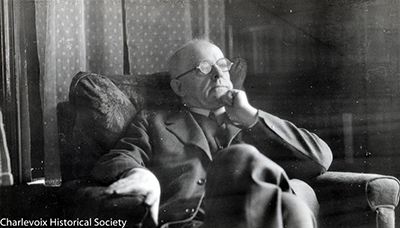Note: As part of its year-long centennial celebration, Munson Healthcare Charlevoix Hospital offers a glimpse into the people who made it what it is today. This is the first in a series.
He helped pioneer medical care through the air to Beaver Island, testified at the “trial of the century,” and often accepted chicken, eggs, and other farm products as payment for his doctoring services.
Robert Bruce Armstrong, M.D., was quite a man. And when Charlevoix needed a hospital, he became an advocate. At its opening on May 5, 1920, he served as its first administrator.

The “History of Michigan” by Charles Moore, published in 1915 nearly 21 years after Dr. Armstrong’s graduation from the University of Michigan’s Medical School and arrival in Charlevoix, had this to say about him:
“His career up to this time had shown that he was persevering, industrious, and energetic, for he had worked his way through college, and had not been content with a mere cursory education, but had thoroughly trained himself in the various branches of his chosen vocation, so that he came to this city fully prepared to take his place among its foremost professional men.”
In other words, he was a great doctor.
Granddaughter Nancy Armstrong Potter of Big Rapids said she came too late into the world to know her grandfather, but knows her father, Robert Bruce Armstrong II, M.D., practiced medicine for a few years with her grandfather in Charlevoix.
“My dad said he was a humanitarian, and a wonderful doctor. He cared about everybody, as did my dad,” Potter said. “From looking at the pictures and remembering stories that my dad told me, he must have had a wonderful childhood. I believe they were a very close-knit family.”
One story about the doctor recounted in Charlevoix Hospital’s 80th Anniversary publication in 2001 has a woman named Francis Durant sharing that she contracted diphtheria in 1902-03 as a child. The disease then was often a death sentence for the young. Diphtheria caused a membrane to form in the throat that eventually cut off breathing.
The physician caring for her told her father that Dr. Armstrong might be able to help her because his shingle said “ENT.” The father found Dr. Armstrong fishing because he was still relatively new in town and not that busy. He pleaded with him to come. Dr. Armstrong replied he was not a pediatrician, but after continued pleas he went and cared for the girl. Within 48 hours she recovered. Dr. Armstrong changed his shingle to “pediatrician” and became very busy.
His late grandson, Robert “Bob” Shanahan, M.D., was quoted in the 80th anniversary publication, saying that his grandfather made his own medicines. That was possible because Dr. Armstrong graduated from the University of Michigan’s pharmacy program before attending medical school.
He also needed to develop strategies for dealing with conditions in homes where he provided care. There were times kitchen doors were put on saw horses to become an operating table – and then there were the other issues.

When Charlevoix Area Hospital opened its doors on May 5, 1920, Dr. Armstrong was elected administrator in charge of the facility. His daughter, Phila, who served as his office manager, became secretary of the hospital board.
In 1923, word came about an accident on Beaver Island and he agreed to help. A U.S. Army Air Corps plane was dispatched from Detroit to fly him to the island. The plane flew across in a snowstorm. Dr. Armstrong helped direct the pilot where to land on Lake Geneserath. They spent three days on the island caring for the young man with a severe head wound. He survived.
In August 1924, Dr. Armstrong was asked by the famous defense attorney Clarence Darrow to testify about 18-year-old Richard Loeb who, with his accomplice Nathan Freudenthal Leopold, Jr., agreed to plead guilty to the kidnap and murder of a 14-year-old boy. Darrow brought Dr. Armstrong to the Chicago sentencing hearing in a bid to get his client a life sentence instead of the death penalty in what was billed “the crime of the century.”
Dr. Armstrong knew Richard Loeb after caring for him following a car accident. His wealthy family owned what is now Castle Farms and spent summers in Charlevoix.
During his testimony, a newspaper account reported Dr. Armstrong spoke about the young man’s nervous symptoms not attributable to the accident. The doctor characterized the accused as slightly “abnormal.” The prosecutor had no questions for the physician.
Loeb and Leopold went on to receive life sentences and a measure of infamy through movie depictions of the crime and their lives – one by Alfred Hitchcock. Loeb would die at the hand of a fellow prisoner in 1936.
During his career, Dr. Armstrong served as surgeon for the Pere Marquette Railway, was a member of the American Medical Association, Michigan State Medical Society, and Charlevoix Medical Society. He died in November 1940. In addition to Robert Bruce Armstrong II, his grandson Robert Shanahan, Phila’s son, became a physician as well.
Nancy Armstrong Potter said one story that sticks out in her mind is how her grandmother, Maud, purchased a house while her grandfather was out of town. According to the story, the doctor arrived back in Charlevoix by train with no clue about his new address – that boasted a wrap-around porch and three stories with a tower – until a porter dropped him off at the stone-walled stairs. Steps to the house on the west side of Bridge Street above Oleson’s grocery are all that remain.
“I am proud to be part of that legacy,” she said. “My dad loved that Charlevoix was his home, you knew by watching his reaction on going back to Charlevoix to visit. He had such a great sense of humor and utmost respect for his father.”
For more information about the hospital and the “100 Years of Caring” celebration, go to munsonhealthcare.org/charlevoix100.